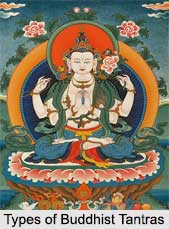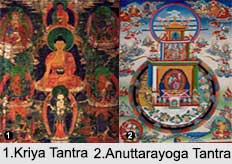 Types of Buddhist Tantras are divided into four categories. The goal of all these tantras bring about enlightenment of the mind. The more commonly accepted types of Buddhist Tantras are, namely:
Types of Buddhist Tantras are divided into four categories. The goal of all these tantras bring about enlightenment of the mind. The more commonly accepted types of Buddhist Tantras are, namely:
1. Kriya Tantra
2. Charya Tantra
3. Yoga Tantra
4. Anuttarayoga Tantra.
The four types of Buddhist Tantras are briefly discussed below:
Kriya Tantra: Kriya Tantra is meant for the sake of candidates who delight in outer action. These outer actions are such actions as bathing, cleaning, etc. These help the sadhaka to purify his body, speech and mind. In the Kriya Tantra, the deity is viewed as external to the sadhaka. The practice of Kriya tantra is believed to lead the practitioner to enlightenment in a span of 16 lifetimes. Kriya Tantra Sadhana involves three methods; they are mediation with muttering (Japa), meditation without muttering and accomplishment of Siddhi after appropriate service (Seva). Susiddhikara and Dhyanottaraopa Talakrama are considered important Kriya Tantras.
 Charya Tantra: Charya Tantra is directed at candidates who delight in practicing outer action and inner yoga in equal measure. The term "Charya" means conduct and it refers to the action to be performed in the ritual and more importantly to the whole conduct of the performer while preparing for the action and carrying it out. The practice of Charya helps the sadhaka to familiarize him with dharma. It is believed to enable him to achieve liberation in 7 lifetimes.
Charya Tantra: Charya Tantra is directed at candidates who delight in practicing outer action and inner yoga in equal measure. The term "Charya" means conduct and it refers to the action to be performed in the ritual and more importantly to the whole conduct of the performer while preparing for the action and carrying it out. The practice of Charya helps the sadhaka to familiarize him with dharma. It is believed to enable him to achieve liberation in 7 lifetimes.
Yoga Tantra: The Yoga Tantra was revealed for the sake of subduing the candidates who delight in the yoga of inner Samadhi. In this case, yoga means union with the Dharmadhatu by means of intense contemplation of a God. Here, ritual and conduct are subordinate to meditation. The student embarks on a journey from the external to the internal. The goal is profound concentration which is gateway to personal liberation. Samadhi is attained by suppressing the wanderings of discursive thought and by fixing the mind one-pointedly on the object of mediation. In the Yoga Tantra, the practitioner imagines himself to be the form body of Lord Buddha. In this way the vulgar body, speech and mind together with their conduct are transmuted in to the Buddha"s body, speech and mind together with their marvellous action. In Yoga Tantra, the sadhaka visualizes himself as the deity and merges the yidam with him. The practitioner is believed to attain liberation in 3 lifetimes.
Anuttarayoga Tantra: The Anuttarayoga Tantra is the incomparable tantra aimed at subduing the candidates who delight in inner yoga. The steps of the path traced out in Anuttarayoga Tantra are divided into two steps. The first is called the path of maturation in which the forms of the male and female deities are visualized within their complete Mandalas. Their forms, Mandalas, symbols and seed-syllables are used to snare and purify the various arising manifestations of the personality. The step of the purification is necessary to proceed to the next process of completion. The steps of completion are called the path of liberation. In it the union of the two purified forms, Mandalas and the seed-syllables of the deities of Wisdom and Means are performed. The whole process is indicated by the word “evamâ€.
Thus, it can be concluded saying that Buddhist Tantras are classified in such a manner that it brings about purification of the mind of the sadhaka and paves his way towards enlightenment.




















